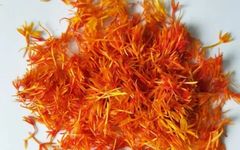The Efficacy, Uses, and Contraindications of Safflower (Honghua)
Safflower, also known as Honglanhua, Honglan, Caohonghua, Cihonghua, Chuanhonghua, Duhonghua, Huaihonghua, Nanhonghua, Xinhonghua, Huanglan, is known for its ability to invigorate blood circulation, regulate menstruation, dispel blood stasis, and alleviate pain. It is used to treat amenorrhea, dysmenorrhea, retained lochia, abdominal masses, chest pain, abdominal pain due to blood stasis, stabbing pain in the chest and hypochondrium, contusions, and swelling and pain from sores.

Safflower (Honghua)
【Name】Safflower (Honghua)
【Alias】Honglanhua, Honglan, Caohonghua, Cihonghua, Chuanhonghua, Duhonghua, Huaihonghua, Nanhonghua, Xinhonghua, Huanglan.
【Source】Safflower is the flower of the plant Carthamus tinctorius, belonging to the Asteraceae family.
【Classification】Blood-invigorating and stasis-dispelling herb.
【Properties】Pungent, warm.
【Efficacy】Invigorates blood circulation, regulates menstruation, dispels blood stasis, and alleviates pain.
【Indications】Used for amenorrhea, dysmenorrhea, retained lochia, abdominal masses, chest pain, abdominal pain due to blood stasis, stabbing pain in the chest and hypochondrium, contusions, and swelling and pain from sores.
【Dosage】3-10 grams.
【Source】2015 Edition of the Pharmacopoeia.
The Efficacy, Uses, and Contraindications of Safflower
【Efficacy and Uses of Safflower】Invigorates blood circulation, regulates menstruation, dispels blood stasis, and alleviates pain. It is used to treat amenorrhea, dysmenorrhea, retained lochia, abdominal masses, chest pain, abdominal pain due to blood stasis, stabbing pain in the chest and hypochondrium, contusions, and swelling and pain from sores.
1. Safflower for retained placenta: Safflower boiled in wine, drink two to three cups. (From “Chanyi Jiyanfang”)
2. Safflower for all types of swellings: Safflower, crushed and juiced, taken orally. (From “Wai Tai Mi Yao Fang”)
3. Safflower for febrile diseases with fetal demise: Safflower boiled in wine, drink two to three cups. (From “Furen Liangfang Buyi”)
4. Safflower for bedsores: Appropriate amount of safflower, soaked in wine and applied externally. (From “Yunnan Zhongcaoyao”)
5. Safflower for contusions and wall injuries: 1 part Chuanma, 2 parts Muxiang, 3 parts safflower, 4 parts licorice. All used raw, ground into powder, taken with yellow wine. (From “Jijiu Bianfang”)
6. Safflower for women’s various wind conditions and abdominal blood stasis pain: 1 liang of safflower. Boil with 1 large sheng of wine until reduced by half, take half at once, repeat if symptoms persist. (From “Jinkui Yaolue” Safflower Wine)
7. Safflower for throat obstruction: 1 small sheng of juice from crushed safflower, taken as needed. If no damp flowers are available in winter, soak dried ones to extract juice as before. (From “Haishang Jiyanfang”)
8. Safflower for chronic ear discharge: 1 part safflower, 1 liang of white alum (burnt to ash). Grind finely and use a small amount in the ear. (From “Shenghui Fang”)
9. Safflower for women’s menstrual obstruction, like blood stasis: Good safflower (finely broken), Su Fangmu (pounded), and Danggui in equal parts. Finely chopped, use 1 liang with 1.5 sheng of water, first boil the flowers and wood, then add 1 cup of wine and Danggui, boil again, and take warm before meals. (From “Zhu Shi Jiyuan Yifang”)
【Contraindications of Safflower】Pregnant women should avoid taking it.
Dietary Therapy Methods
1Safflower Glutinous Rice Porridge
Ingredients: 10 grams of safflower, 10 grams of Danggui, 15 grams of Danshen, 100 grams of glutinous rice.
Preparation: First, decoct the herbs, strain to obtain the juice, then add rice to cook into porridge.
Usage: Take twice daily on an empty stomach.
Efficacy: Nourishes blood, invigorates blood circulation, and regulates menstruation. Suitable for those with menstrual irregularities and blood deficiency or stasis.
Excerpted from: “Minjian Fang”

